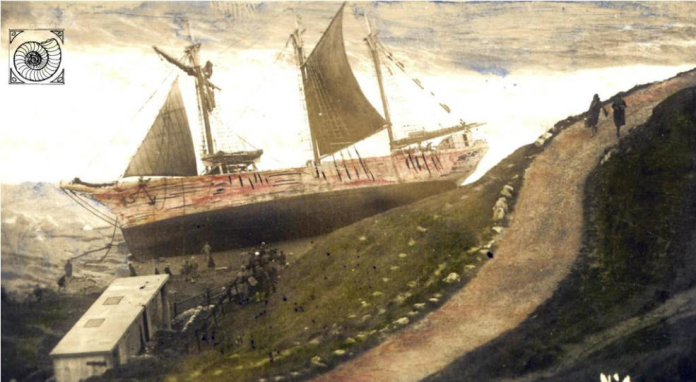I have been asked by the author of an exciting new Dorset history book to post up the foreword to his book. It’s called Treasure of the Golden Grape and tells the exhilarating story of a Dutch Trading Ship out of Amsterdam that was wrecked in a storm of the Chesil beach in 1641. The story goes on to tell of the Dorset locals who salvaged her cargo and of what they went on to do during the English Civil War. Some of whom (The Crabchurch Conspirators) caused the deaths of over 500 people in Weymouth, most in just one night of bloodletting, mayhem, and heroism. Mark Vine.
FOREWORD
As any diver will tell you, the first question you are asked is, “do you dive on wrecks?” If so, this is followed swiftly by “have you ever found any treasure”? They have all heard of doubloons and pieces of eight, yet very few would recognise them. We didn’t.
Local Dorset author and poet Thomas Hardy named the waters bound by the 18 miles of Chesil Beach as Deadman’s Bay for good reason. Dead men were indeed frequently washed ashore, sometimes from one of the 180 known shipwrecks that hit the beach but often from unknown and unseen shipwrecks that foundered during the night, for once caught in that bay with a SW gale blowing, there was usually only one fate that awaited any ship and those on board.
People associate shipwrecks with treasure, and together these conjure up visions of swashbuckling heroes, daring deeds, nefarious characters, romance and adventure. The wreck of the Golden Grape has all of these as the events of the wreck itself unfold to incorporate unforeseen consequences in the turbulent times that followed, where the gibbet awaited some of those involved in the wreck. Equally it was not possible to isolate the wreck from the piracy, smuggling, and privateering that went on before the wreck and which involved the local gentry right up to the Queen herself.
The full story is based on the archive records of a contemporary High Court of the Admiralty Inquiry into the wreck and the salvage of this early 17th century Dutch ship, wrecked in December 1641 on the Chesil Beach opposite Wyke Regis in Dorset. As well as the surviving crew, over three hundred local inhabitants from the towns of Portland, Melcombe Regis and Weymouth and the surrounding villages, from Wyke, Chickerell, Fleet and Langton Herring to as far as Abbotsbury, gave evidence about the shipwreck. They detail what they had salvaged from the wreck and specify how they lived, their family, their home, and their occupation, and in doing so, they mention another 200 people in their sworn testimony.
The Golden Grape sailed first from Holland, half laden with goods, to Dover. There the crew loaded more trade goods and took on an English Captain and more crew for the longer voyage to Cadiz to exchange their cargo. At Cadiz they loaded barrels of raisins of the sun, jars of oil, sherry, tent and other wines. A fairly mundane cargo so far but it is then that they slipped surreptitiously into the bullion port of Sanlucar de Barremeda, a satellite port to Seville, the Spanish port and centre of trade for all the riches of gold and silver from South America.
Spain either couldn’t supply all the necessary goods, or goods at the right price, to her colonies in the New World so they were smuggled into Spain and paid for in smuggled South American gold and silver by their merchants, well out of the gaze of officials in Seville.
In exchange for the rest of the Golden Grape’s outbound cargo, consisting of barrels of the highly valued spice pepper, Spanish boats brought out two bags of red wool and forty-three bolts of taffeta silk, two bags of silver plate, a bag containing five hundred pistoles [Spanish 2 escudos gold coins later known as doubloons], another a mixture of pistoles and pieces of eight, an unspecified number of bags of pieces of eight, a peg of silver and a loaf of silver to be loaded on board the Golden Grape.
From there she sailed back, intending to trade in France, then to Dover, but half way up the Channel the Golden Grape encountered a fierce storm and was wrecked on the Chesil Beach, where she sat a whole for 4 days while she and her goods were plundered. There is even a James Bond mentioned, but it is Walter Bond and his leader Fabian Hodder who feature in the wreck and in the events that follow.
* Conspiracy led them to their doom
All rotting in the late winter gloom
Hodder has flown the nest
The Bridport Dagger awaits the rest
They’ll all be dancing very soon
Yes all to the hangman’s tune.
Piracy, Smuggling, Slavery,
Shipwreck, Treasure,
Civil War, Conspiracy, Hanging.
An extraordinary story of maritime folk.
*Lyrics written by Mark Vine, taken from the superb “TheCrabchurch Conspiracy” album by The Dolmen, lyrics and story by Mark Vine, music by Taloch aka Tony Jameson, (Josh Elliott, Jez Lee).
https://www.deadmansbay.co.uk/







